Venturing South of the Equator: American Samoa
Visiting all of America’s National Parks must include a trip to National Park of American Samoa, the only National Park south of the equator. Located in the south Pacific, this remote chain of volcanic islands are next door to Western Samoa and closer to Fiji and Tahiti than anywhere else you may recognize.
American Samoa is a US Territory – English speaking and using US currency – but be aware that it has it’s own government and immigration laws.
HINT: You will need a passport to visit!
National Park of American Samoa
Unlike other National Parks that are owned and operated by the Department of the Interior, the National Park of American Samoa was established in partnership with the local Samoan government, on land leased to the National Park Service for a term of 50 years. The National Park Service manages the infrastructure, puts up signs and helps promote the park, but the land is still owned by the local chiefs and the villages.
This National Park is both on land and under water. It preserves the only mixed species paleotropical rain forest in the United States. Lush and beautiful, and home to three types of bats. You’ll see them come out a dusk. You can’t miss them – some of the fruit bats have up to a 3 foot wingspan! You’ll think you are looking at Batman.
About one third of the park is underwater – home to sea turtles, coral and an amazing diversity of sea life. If you are a diver, you will be in heaven. We aren’t – but we did snorkel and that was great!
Hiking in the National Park
There are several hikes in the National Park.
Mount Alava
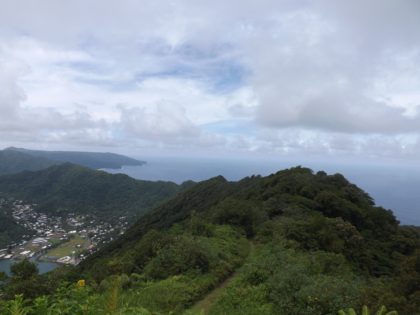
The longest and hardest hike is to Mount Alava. We began on the west side at Fagasa Pass and hiked east, then down to the seaside village of Vatia. You can get a bus to the beginning and take a bus back from the end – provided the busses are running that day. (But note, you can always pick up a ride with a villager. Don’t be afraid to ask. American Samoans are the friendliest people on earth!)
The views are spectacular. You hike up to the communications towers and the site of the old cable car that people rode to the top of the mountain. Amazing views of Pago Pago (pronounce Pongo Pongo) Harbor. In the old days, the cable car used to stop over the harbor and dropped flowers on the cruise ships!
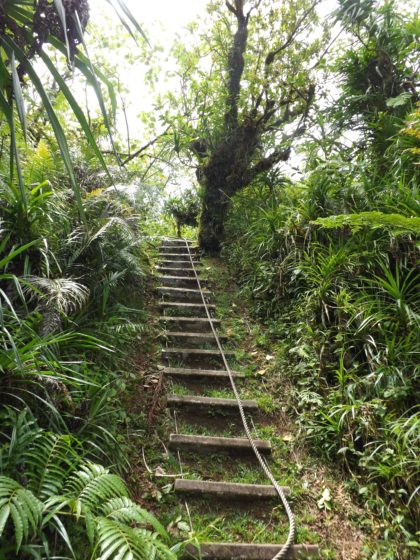 The way down to Vatia is crazy… remember the game “chutes and ladders”? You’ll be holding a rope and going down stone stairs most of the way.
The way down to Vatia is crazy… remember the game “chutes and ladders”? You’ll be holding a rope and going down stone stairs most of the way.
Try to go when it is not raining! Also it is much easier to go down this way than up. That’s why we started at the west end of the trail.
Blunts Point and WWII Heritage Trail
Another trail is the Blunts Point and World War II Heritage Trail. Start from “town” at the IBM Laundromat (really!) and hike up to old gun emplacements and then to the other end of the cable car. Interesting history and great views. Worth the climb. You will get a bit more chutes and ladders going down, but they are not too hard. You’ll end up back in town near the Ocean Center.
Pola Island
Another nice but easy hike is west of Vatia to see Pola Island – a perfect photo spot! Drive (or take the bus) to Vatia and walk to the end of the road. There are National Park signs to guide you. If you drive, there is a small parking lot at the end of a very rough road.
Hint: They warn you about the dogs, but we didn’t see any. There are dogs all over the island but if you face up to them, they pretty much go away. If you feel threatened, just lean over like you are picking up a rock and they’ll go away.
Other Islands
The National Park includes sites on the Manu’a Islands – Ofu and Ta’u. We did not visit these – they are a bit more challenging to get to and have limited accommodations. It will take a bit of work on logistics to go there.
You can fly but the flights only go on certain days. You can also take a boat, but be sure you have the return trip arranged. If you want to visit there you will have to be flexible.
National Landmarks
In addition to the National Park, the National Park Service and local villages have established a number of National Landmarks – voluntary preserves. These are managed by the people in the villages, not formally developed but worth a visit. They are happy to have you there, but in most cases you will have to ask permission to visit since the land is owned by the village chiefs.
Cape Taputapu National Natural Landmark
Cape Taputapu landmark is at the far west end of the island, but not easy to get to. Watch out for the tide. You can walk there from the village, but you need to go at low tide. Remember to ask for permission if you see villagers.
Fagatele Bay
One example of a voluntary preserve is Fagatele Bay National Marine Sanctuary. It is amazing, but not easy to get to. The website says you have to take a boat to get there, but you can walk in. Here are the directions you will get… at the sign walk down the street past the landfill to the gate and then ask at the house there for permission to visit. They will charge you – probably $5 per person – and then let you pass through the gate and walk on their land to the beach.
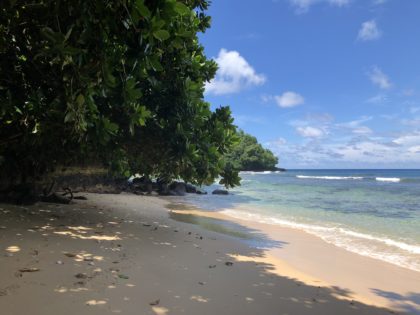
It is one of the most remote beaches you can visit – 3/4 mile from the nearest house, in a small shady cove deep in the bay. Not an easy walk, but the trail is well marked and ends in stairs, most of them intact but a few missing:-)
We were the only people on the beach. Amazing!!!
Hint: Go at high tide so that you get the best snorkeling.
Cultural Experience
A very important part of your visit to American Samoa is the cultural experience. It is not only the natural experience – the jungle and the reefs – the people and way of life are unique. Of course there is a video at the National Park office, but take the time to meet the people and talk to the villagers.
One thing you will find everywhere is how friendly the people are. Everyone waves and greets you. Tourism is not a big thing and communities are very small and tight-knit, so they know you are a visitor and they want to greet you. If you are walking around, people will stop and offer you a ride. Take it! It’s safe and you will meet some really interesting people. You will be amazed at how many have lived or have family living on the mainland – even in your home town! Its a small world.
You may want to hire a car for a few days so you can get out to the remote parts of the island, but most places you can get to by bus. They go everywhere,and it is easy and cheap – usually just a couple dollars.
Hint: You pay when you get off the bus, not when you get on. They don’t run on Sunday or holidays.
Getting to American Samoa
As we mentioned, American Samoa is not a busy tourist destination. There are only a couple flights a week from Honolulu – Monday and Friday. You arrive at 9:30 pm and that’s the same plane that you will take when you leave. Monday or Friday departure at 11:30 pm.
Accommodations
Don’t expect “resort-type” accommodations or activities. Most people who visit American Samoa come on business or to visit the National Park. There’s nice hiking and good beaches, but you have to make your own itinerary and entertainment.
You won’t find the fine restaurants and fancy hotels that most tourist destinations have. But be open and ask the locals where to eat. The best sushi we had was at the KS Mart – a grocery store and bakery and restaurant. No ambiance, but amazingly fresh food! Great creampuffs too.
Our Recommendations
We don’t typically promote specific properties or accommodations but we found that there isn’t much information available regarding American Samoa.
East End
There aren’t many accommodations – only a few hundred rooms spread across the island. We chose to experience the culture by staying in a beach “fale” at Tisa’s Barefoot Bar, on the east end of the island at Alega. In fact, it is the only accommodation east of Pago Pago.
Even though the name conjures up a south seas bar filled with folks drinking rum drinks, it is not that way at all. In fact, Tisa and Candymann limit the number of visitors so that they can offer a personalized experience.
Don’t expect luxury. You’ll be sleeping in an open air a-frame under a mosquito net with outdoor bathrooms and shower. But it’s a “million dollar view”. You can lay in bed and watch the sunrise/sunset, and be lulled to sleep each night by the waves.
You’ll also be spoiled by the food. Candymann loves to cook and prepares breakfasts and dinners from local organically grown ingredients, most grown right there. Your room rate includes breakfast and dinner (not lunch), and you will be happy about that. There really aren’t any restaurants on that side of the island.
Be sure to bring your snorkeling gear. Tisa’s is situated in a beautiful cove that is now a marine sanctuary. The snorkeling and swimming is fabulous. Tisa and Candymann take great pride in how they have been able to conserve the reef and will personally take you out to the best snorkel spots.
A few days there will give you a good flavor for the culture and a much better insight in to the American Samoan society.
West End
From there, we went to the other end of the island and stayed a few days at Moana O Sina. It is a totally different experience. Unlike the white sand beaches at Tisa’s, this hotel looks out over black lava cliffs with water crashing waves and water spouts. Gorgeous.
It’s a small boutique hotel – just 9 rooms and a bungalow. It offers a different type of south seas hospitality and a different feel of the island. Closer to the airport, this area is a bit more developed and lively. There’s even a golf course – not fancy, but with amazing views.
Hint: If you plan to golf, take some golf balls and tees. You can rent some beat up clubs but they don't have the kind of "pro-shop" you might expect.
Eating and Shopping
Most of the restaurants on the island are in Pago Pago or Fogatogo, and so are the shops. Every village has at least one small convenience store, but you won’t find many tourist shops with t-shirts or souvenirs. We found a couple in Fogatogo, but you have to ask where things are made. Many things come from Western Samoa, not American Samoa. Ask and you will find locally made items.
This National Park is an adventure of a lifetime!
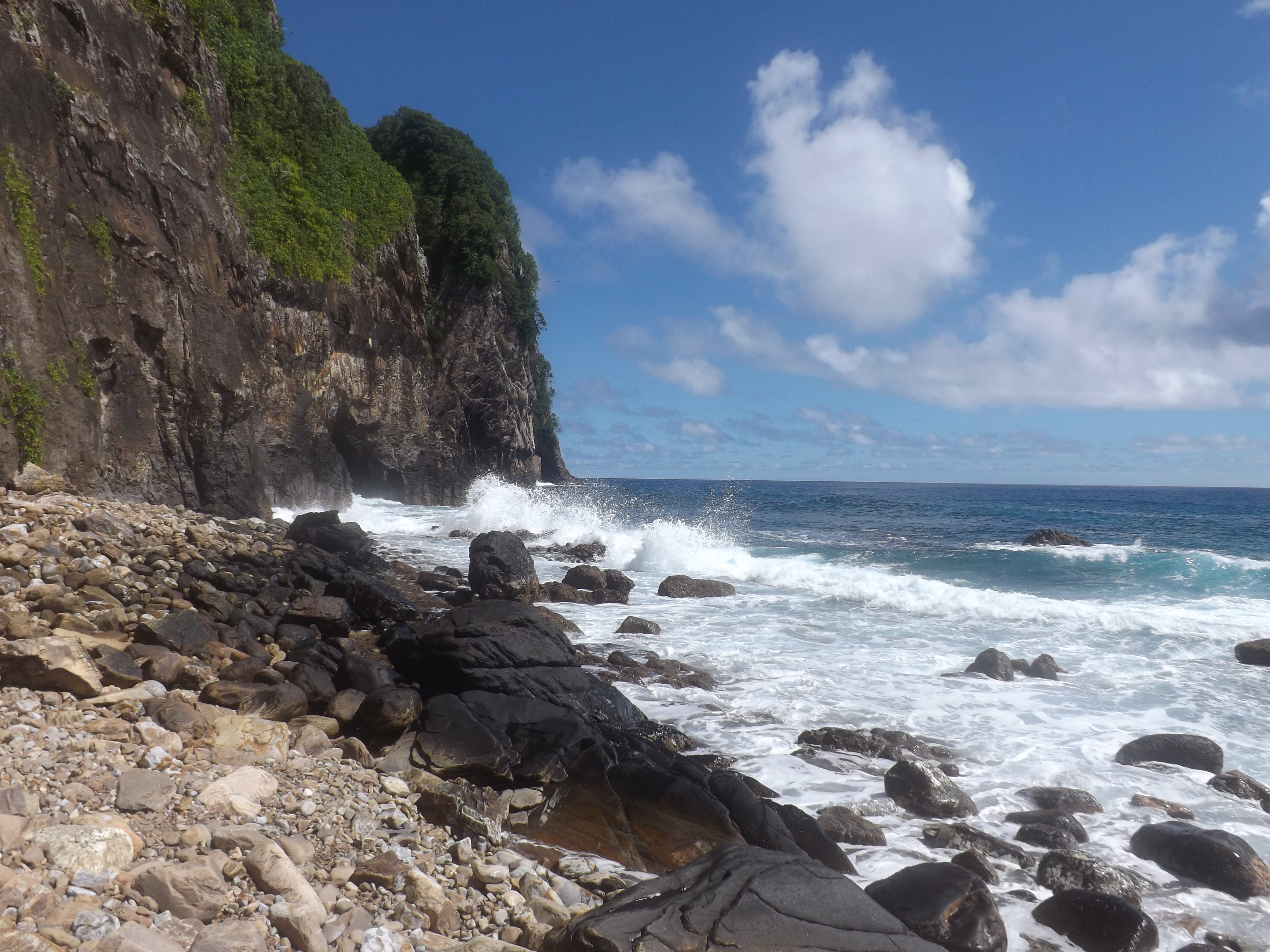
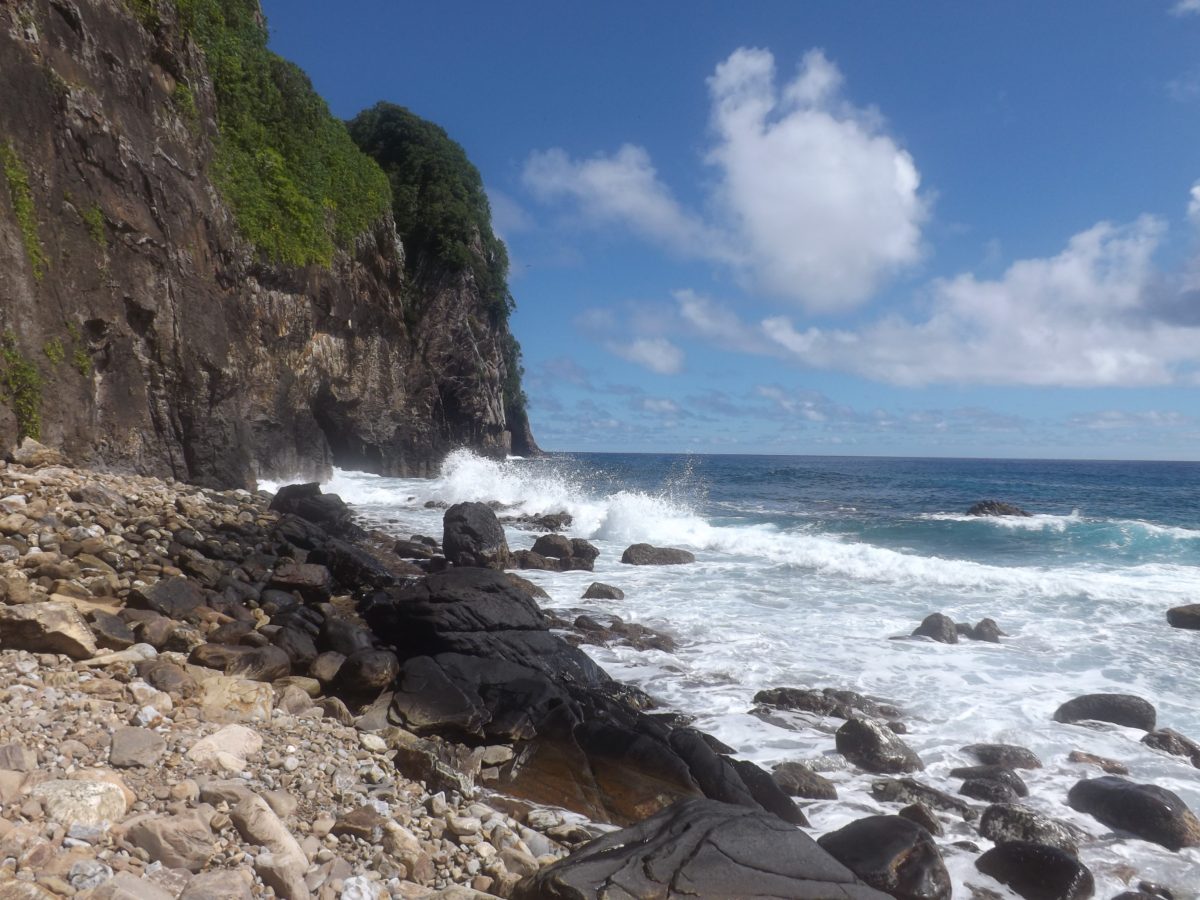
You guys are awesome! Love to follow your adventures and I want to be like you guys when I grow up! Nice write up!